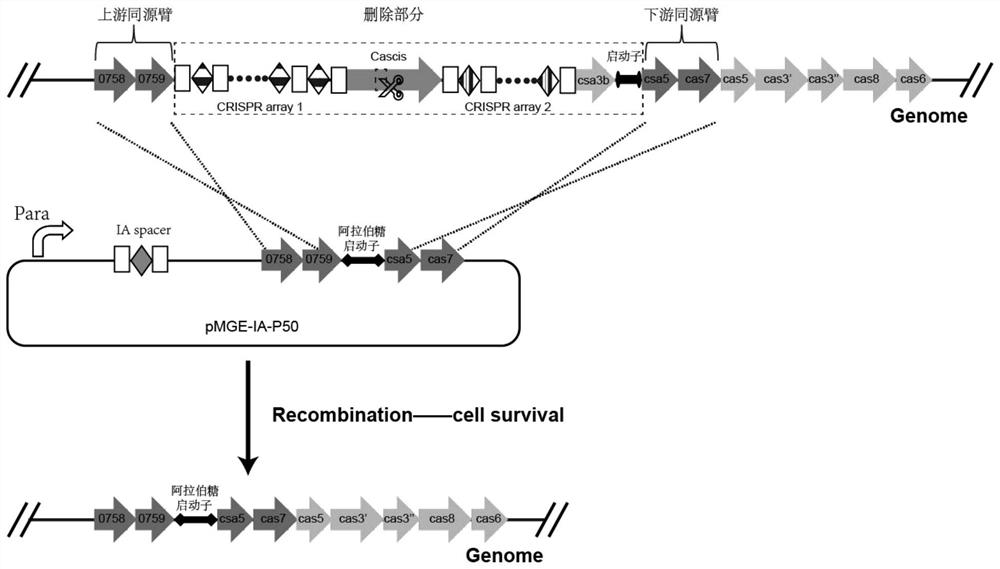Construction method of inducible endogenous CRISPR-Cas system and application of inducible endogenous CRISPR-Cas system in simultaneous editing of multiple genes
A construction method, an inducible technology, applied in other methods of inserting foreign genetic materials, genetic engineering, biochemical equipment and methods, etc., can solve time-consuming and labor-intensive problems that cannot meet the requirements of archaeal model organisms for chassis cell efficiency, archaea Long bacterial growth cycle and other problems, to achieve the effect of wide host range, high gene editing efficiency, and time saving
- Summary
- Abstract
- Description
- Claims
- Application Information
AI Technical Summary
Problems solved by technology
Method used
Image
Examples
Embodiment 1
[0059] Construction of strains containing inducible endogenous CRISPR-Cas system and deletion of CRISPR array
[0060] In this example, the construction of a Sulfolobus Icelandicum Rey15A mutant strain containing an inducible endogenous I-A CRISPR-Cas system is illustrated as an example:
[0061] 1. Construction of Single Editing Plasmids
[0062] (1) The gene cluster of the I-A CRISPR-Cas system on the Rey15A genome of Sulfolobus Icelandicus contains csa5, cas7, cas5, cas3, 'cas3, 'cas8 and cas6 genes, and the promoter of the gene cluster is in the upstream region of the csa5 gene. There is also a spacer-acquired gene cluster (Cascis) and two CRISPR clusters (C RISPR array1 and CRISPR array2) upstream of the gene cluster. In order to replace the self-promoter of the I-A CRISPR-Cas system gene cluster with an arabinose-inducible promoter, the sequence "T GGGCTGCTATAGAAGCTATCTTCAGAAAGGCAAATAAGG" in the csa1 gene upstream of the I-A gene cluster was selected as protospacer, wit...
Embodiment 2
[0079] A method for utilizing an inducible endogenous CRISPR-Cas system to realize simultaneous editing of multiple genes on a prokaryotic genome, comprising the following steps:
[0080] This example utilizes Sulfolobus Icelandicus P 50 IA, take the knockout of the SiRe_2599 and SiRe_0020 double genes on its genome as an example to illustrate:
[0081] 1. Construction of Editing Plasmids
[0082] (1) SiRe_2599 on the S. islandicus REY15A genome selects a total of 40 bases from +633 to +683 as protospacer1 (S1) and SiRe_0020 selects a total of 40 bases from +214 to +264 as protospacer2 (S2) , the 5' ends of the above S1 and S2 sequences are adjacent to CCN-PAM (protospacer Adjacent Motif), so they can be targeted by the host endogenous I-A type CRIISPR-Cas system. Four primers (2S-S1-2599-F / 2S-S1-2599-R / 2S-S2-0020-F / 2S-S2-0020-R) were designed based on the above two protospacer (Table 1), and the four primers were added (20:1:1:20) ratio to obtain CRISPR cluster fragments b...
Embodiment 3
[0090] A method for utilizing an inducible endogenous CRISPR-Cas system to realize simultaneous editing of multiple genes on a prokaryotic genome, comprising the following steps:
[0091] This example utilizes Sulfolobus Icelandicus P 50 IA, as an example to illustrate the knockout of the SiRe_1994 and SiRe_0811 double genes on its gene:
[0092] 1. Construction of Editing Plasmids
[0093] (1) SiRe_1994 on the genome of Sulfolobus Iceland REY15A selects a total of 40 bases from +160 to +200 as protospacer3 (S3) and SiRe_0811 selects a total of 40 bases from +408 to +448 as protospacer4 (S4), the above S3 Both the 5' end of the sequence and S4 sequence are adjacent to CCN-PAM, so they can be targeted by the host endogenous type I-A CRIISPR-Cas system. Four primers (2S-S3-1994-F / 2S-S3-1994-R / 2S-S4-0811-F / 2S-S4-0811-R) were designed based on the above two protospacers (Table 1), and four primers were added ( 20:1:1:20) to obtain CRISPR cluster fragments by PCR.
[0094] (2) Th...
PUM
 Login to View More
Login to View More Abstract
Description
Claims
Application Information
 Login to View More
Login to View More - R&D
- Intellectual Property
- Life Sciences
- Materials
- Tech Scout
- Unparalleled Data Quality
- Higher Quality Content
- 60% Fewer Hallucinations
Browse by: Latest US Patents, China's latest patents, Technical Efficacy Thesaurus, Application Domain, Technology Topic, Popular Technical Reports.
© 2025 PatSnap. All rights reserved.Legal|Privacy policy|Modern Slavery Act Transparency Statement|Sitemap|About US| Contact US: help@patsnap.com



